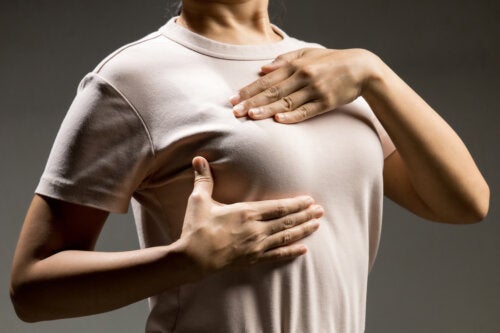Breast Lumps During Breastfeeding: Possible Causes and Solutions
Breast lumps during breastfeeding are common signs that should be treated promptly. We'll tell you what they're due to and what to do about them.

The first months of breastfeeding are often the most difficult for the mother, as they’re sometimes accompanied by bothersome signs and symptoms. Have you developed breast lumps and are breastfeeding? Don’t worry! In the next article, we’ll tell you what the most frequent causes of this condition are and how you can solve them.
I have breast lumps during breastfeeding, what does it mean?
Lumps in the breast during breastfeeding are quite common. They’re usually caused by engorgement of the milk ducts, the thin tubes that carry milk from the milk gland to the nipple.
Blockage of these ducts causes fluid to accumulate inside and swell the walls of the ducts. For this reason, you may feel a hard, painful formation under the skin of your breasts. Occasionally, you may also notice warmth and redness in the skin tissue above the hardness. Most commonly, you’ll locate the lumps in the area near the armpits.
This problem is quite common among new mothers, especially during the first few months of breastfeeding. Despite good preparation, the start of breastfeeding and the baby’s adaptation to the breast can produce an imbalance between milk production and milk flow.
However, if these lumps are very painful and the skin becomes very sensitive at the slightest touch, it’s important to ask for a specialist’s evaluation. It’s essential to rule out mastitis in this context.

Most common causes of breast lumps during breastfeeding
As we’ve seen, these breast lumps are usually the result of milk accumulation through an obstructed duct, which in turn is due to the following conditions:
- Poor latching: when the baby doesn’t latch on well and the suction of the breast isn’t effective, not enough milk will come out. As a consequence, this fluid will accumulate in the breasts and form these annoying lumps.
- Insufficient emptying of the breast: it should be taken into account that it’s necessary for the baby to empty one breast first and then offer the other. Otherwise, there’s a greater risk that the milk will accumulate and form these lumps. Also, the baby may not get enough fat from the milk that appears at the end of feedings, which will cause insufficient weight gain.
- Pressure on the breasts: if the bra or clothing worn at this stage is too tight, it won’t allow free circulation in the breasts and will favor engorgement. The same happens when the mother sleeps on her stomach and puts pressure on the breasts.
- Infrequent feedings: if several hours pass between feedings, the milk produced is likely to accumulate and form lumps. Remember that in the first weeks of life, the baby should have between 8 and 12 feedings a day.
- Excessive milk production: some mothers produce a large amount of milk and their babies aren’t able to consume all of it. This causes the breasts to not empty completely after feedings and the fluid accumulates inside.
- Infection (mastitis): if this engorgement isn’t treated in time, the lumps could cause an infection. If so, the mother should be evaluated by a specialist as soon as possible.
Other possible causes
Other possible causes of breast lumps during lactation shouldn’t be disregarded, among which the following stand out:
- Breast abscess: this is the complication of a superficial skin infection or mastitis. In this case, the lump is very painful, the skin covering the area becomes red, tight, and shiny. In some cases, it may promote the discharge of pus. It should be treated as soon as possible with antibiotics.
- Galactocele or milk cyst: this lump is characterized by the accumulation of fatty tissue outside the milk ducts. It’s not painful and tends to disappear spontaneously after a good feeding.
- Fibroadenoma or hamartoma: these are benign tumors that may appear during lactation.
- Breast cancer: although rare, breast lumps during breastfeeding may also be due to a malignant tumor. For this reason, it’s important to discuss it with your doctor if the lump persists over time.
How to relieve breast lumps during breastfeeding
When these breast lesions appear, it’s crucial to pay attention to them and focus on treating them in order to prevent complications. Then, take into account the following tips to alleviate the discomfort in your breasts:
- Continue breastfeeding normally. Feed the baby on demand, because if you stop breastfeeding, the condition may worsen.
- Empty the affected breast and offer it first at the next feedings. If you notice that the breast is still engorged between feedings, pump the breast or hand express the remainder.
- Apply cold compresses after breastfeeding. This helps to decongest and reduce inflammation and pain. It’s not appropriate to apply heat, as it favors the proliferation of bacteria that increase the risk of infection.
- Position the baby. Use an appropriate method to drain the engorged breast area. For this, orient the baby’s chin towards the place where the lump is located. That is, if the lump is under the breast and in the internal area, use the classic breastfeeding position. If it’s below and on the outside, then implement the rugby ball position.
- Massage the affected breast in a circular motion from the base of the breast toward the nipple. Perform this massage before breastfeeding, while breastfeeding, or before pumping. This technique helps to release blockage in the duct.
- Wear a special nursing bra that doesn’t fit tightly, and choose comfortable clothing. Also, avoid sleeping and resting positions that put direct pressure on the breasts.

Can you prevent the appearance of these lumps?
To prevent the appearance of these annoying lumps, the key is to favor the flow or drainage of milk through the milk ducts. To do this, offer the breast on demand, use a breast pump if necessary, and alternate breastfeeding positions.
Breast lumps are the result of engorgement and usually last approximately 3 days. The pain will subside after emptying, but may reappear when the breasts fill with milk again. Take into account the care described above to alleviate this symptom and avoid complications.
It’s important to note that if the appearance of these lumps evolves into acute pain in the breast, redness, heat in the area, fever, and discomfort, mastitis should be ruled out. Consult a specialist for guidance on the steps to follow.
Similarly, it’s advisable to seek advice from a lactation consultant in order to determine what causes these lumps and resolve the problem as soon as possible.
